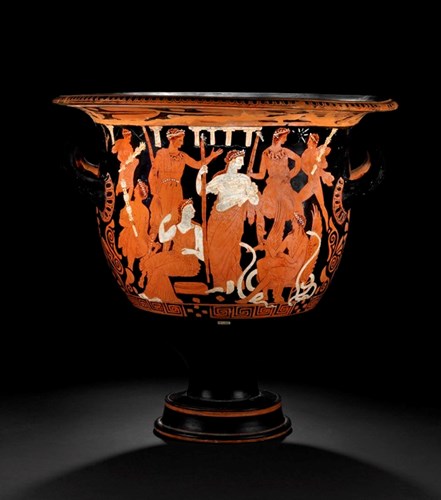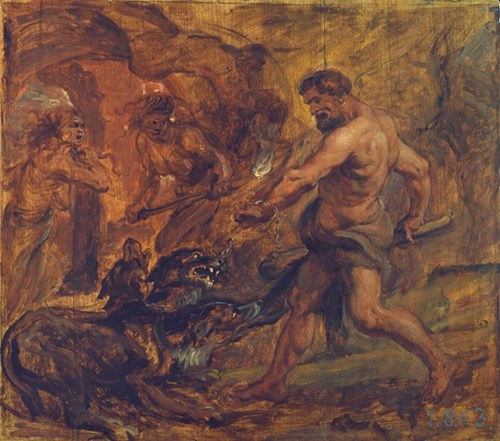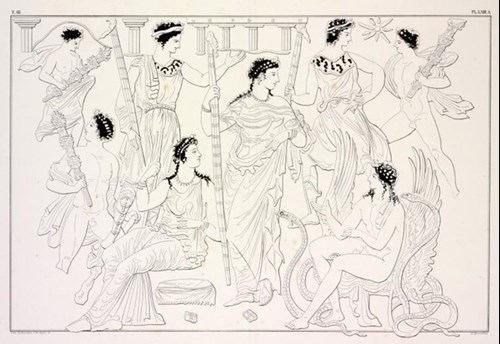The initiation of Heracles
Heracles was the quintessential hero in Greek mythology, the son of Zeus and Alcmene. He was the greatest Greek hero, founder of royal houses and defender of order against many chthonic monsters that threatened humanity. To expiate for the slaughter of his children, he was forced to carry out twelve labours set by King Eurystheus of Mycenae. The final labour was the capture of Cerberus, the hound of Hades. It was a three-headed dog with a serpent for a tail and snakes protruding from multiple parts of his body that guarded the gates of the Underworld to prevent the escape of the dead. It was a task that required more than brute strength, canning, and violence. The Underworld was not a place for the soft-hearted, and navigating its treacherous geography required skill and knowledge. Heracles knew that the initiates of the Eleusinian Mysteries could depend on the assistance of Demeter and Persephone, who ruled this dark domain as the spouse of Hades, so he decided to visit Athens and become an initiate.

But there was a significant problem. The Mysteries were not open to those with blood on their hands, and Heracles had bathed in the blood of the Centaurs whom he had slaughtered without mercy. There was also the problem of his citizenship (or lack of it) since only Athenian citizens had the right to participate in the Eleusinian Mysteries. The solution to both problems came with the establishment of a new ceremony. First, the Athenian Pylios adopted Heracles and made him a citizen of Athens (Pylios means “the one of the gate”, a propitious name for someone about to pass the gates of the Underworld). Then Demeter founded the Lesser Mysteries as a favour to Heracles and performed a ritual to remove the bloodguilt. The process involved the application of the “fleece of Zeus” (Dios kodion), the fleece of a ram placed under the foot of those who wished to be purified from their guilt.

The initiation served its purpose. Heracles was able to enter the Underworld and locate Cerberus. From the late sixth century BCE, a selection of vases depicts the moment Heracles approaches the fearsome beast. He lowers his club and chain and pets Cerberus watched by Persephone. The goddess gave permission for the hero to remove the dog from her infernal kingdom. According to Euripides, when Heracles returned to the light, his father asked him whether he overpowered Cerberus or received him as a gift from Persephone. The hero attributed his success to a combination of his personal strength and Persephone’s benevolence.

Heracles’ initiation served political and religious purposes. First, his initiation was a testament to the Mysteries’ popularity and relevance. According to a version of the myth, the Athenian hero Theseus suggested that Heracles should be initiated into the Mysteries. Furthermore, various ancient authors claim that Eumolpus himself initiated Heracles to the Eleusinian Mysteries. These connections between Athenian and Eleusinian heroes and the son of Zeus forged strong bonds between the quintessential Greek hero, Athens, Eleusis, and the Mysteries. Heracles’ initiation explained the opening of the Eleusinian Mysteries to non-Athenians and provided a reason for establishing the Lesser Mysteries. Heracles’ successful journey to the Underworld inspired faith in future initiates that they would also form a strong bond with Persephone that would improve their chances of a blessed afterlife.
Bibliography
Cosmopoulos, Michael. Bronze Age Eleusis and the Origins of the Eleusinian Mysteries, Cambridge: Cambridge University Press, 2015.
Mylonas, George. Eleusis and the Eleusinian Mysteries, London: Routledge, 1962.
Papangeli, Kalliopi.Eleusis: the archeological site and the museum, Athens: Omilos Latsi, 2002.
Smith, William. A Dictionary of Greek and Roman biography and mythology. Boston: Little, Brown and co., 1867.
Image source: Aikaterini Laskaridis Foundation
Otto Magnus von Stackelberg (1854): Landscape with Ilissus river.
Image source
Boston Museum of Fine Arts - Unknown artist (16th c.): Relief with the Battle of the Centaurs and the Rape of Persephone.
The British Museum - The Pourtalès Painter (380-360 BCE): Initiation of Heracles and the Dioscuri into the lesser mysteries at Agrae (or Eleusis).
Museo Nacional del Prado - Peter Paul Rubens (1636-1637): Hercules and Cerberus.
The New York Public Library - Auguste-Gaspard-Louis Desnoyers (c. 1844-1861): The introduction of Hercules and the Dioscuri, Castor and Pollux, in Eleusinian mysteries


